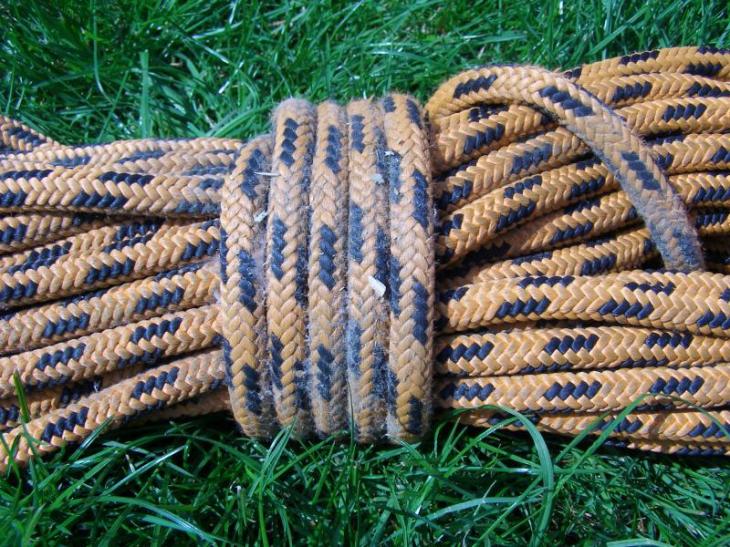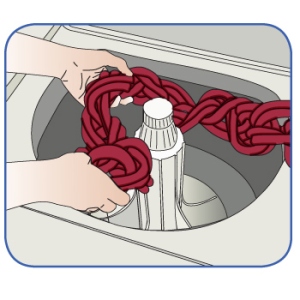contributed by Dan Rudie
Perspective first, answer second —
“Will mold and mildew affect the strength of my rope?”

Greenpeace activists hang a large warning box on the outside of an E.ON coal-fired power plant at the Maasvlakte. Photo: Philip Reynaers – June 2006.
Like most climbing questions, there is no single definitive answer. It depends. Most climbing things we have learned and probably pass on others are “rules and rote”. Since climbing can be dangerous, we learn rules that we guard as absolutes. For example, “Never smoke cigarettes around your gear” and then you find that occupational folks do it all the time with no discernible problem. Or never use bleach on rope period, then find out that fire rescue teams have protocols for decontaminating ropes with bodily fluids using chlorine bleach solutions.
Here’s a story to highlight my point.
I remember long ago being taught that if I dropped a carabiner from six feet on to concrete it could cause fractures that could cause it to fail under load. Is that true? Are carabineers really that fragile? Well the answer is no, not anymore, but they once were. When the first aluminum carabiners were made for the military the gates were made of cast aluminum. They were subject to fractures and cracking where the pin connects the gate to the main body. The military didn’t use them for lead climbing and tended not to put them in shock loading situations. These wonderful light weight carabiners quickly made their way into the climbing community and eventually so did gate failures which were much more severe from a leader fall shock load. These little lightweight gems were handled like eggs and strict rules were formed. Many people still adhere to these rules today not knowing why the rule was formed or if it still applies. Guess what? It doesn’t. Carabiners haven’t used cast aluminum for almost four decades (read about the history of carabiners). Tests have been done where modern forged aluminum carabiners have been hurled down 40 feet onto solid rock and they break tested 100%. Many modern carabiners could actually be made stronger by smashing them with a hammer as the metal could be further cold forged. Not that you should try this but it adds some color to the picture. If you don’t know the basis of a climbing rule stick to that rule, it could save your life after all.
“If you don’t know the basis of a climbing rule stick to that rule, it could save your life after all.”

“SO WHAT ABOUT MOLD AND MILDEW?”
Mold and mildew will not have any appreciable strength reduction for the fibers used in modern life safety ropes (nylon, Kevlar, spectra, Dyneema, etc). Long ago climbers used manila, hemp, sisal and various other natural fibers and mold could destroy these types of rope in very short order. In those days if you stored a rope wet, you might just as well stored it in the trash can. Synthetic fibers have entirely replaced natural fibers in the climbing world. Since almost all life safety ropes that stretch are made of nylon, let’s focus on that. Mold and mildew cannot “feed” on nylon. The bacteria will not eat or dissolve the nylon fibers. If you have nylon fabrics that are in fact covered in either mold or mildew, the mold or mildew is growing on something else in or on the rope (sweat, urine, sugar, etc). If, for example, you had a rope that became wet and developed mold and you took that rope and thoroughly dried it, the moldy dry rope would be far stronger than an identical new wet rope. Nylon can lose about 20% of its strength when soaking wet. Most climbers wouldn’t worry about using a wet rope if they got caught out in the rain (or for that matter the knot that can reduce 20 – 40 %). Now, if you had a rope that was covered in mold or mildew, strength is not an issue, but friction might be. Rappelling or friction hitches on a mildew clad rope might require additional measures to add friction. Naturally one would clean and dry the rope before using it, so this not likely to be an issue. But worth knowing if you are faced with that situation.
In my experience what most climbers think is mold and mildew is actually staining. Nylon fibers will absorb water (which is why wet ropes are weaker) in this process ropes that have become wet (either soaked or from humidity) will absorb a lot of staining materials as well. Even nylon ropes that have never been wet or humid will absorb very small particles of “gunk” and cause the rope to discolor (white ropes do not stay white for long). No amount of cleaning will remove these absorbed stains. Just imagine all the aluminum powder, chalk, dirt, sweat, etc, that covers any average rope. Get the rope wet and all that dark gunk will soak into the fibers. Not to worry as they are just colored particles and too small to cause any damage (grains of course sand are a different story). Coil a rope with your bare hands after a day of climbing and you will see on your hands how dirty ropes are. If you actually are dealing with mold, mildew or other bacteria, when dried you will see spores and powder growing larger than the rope fibers. You would be able to scrape some off and see the pores becoming airborne. If you are dealing with mold and mildew, you will just need to wash the gear and dry it properly. It will still be covered in stains when you’re done, but this will have no effect on the strength. As always, properly storing gear to keep it dry is wise well practiced rule. However a rope stored for a year in distilled water, that is then properly dried is still as good as one stored dry. But a nylon rope soaked for a year in chlorinated tap water is not (though still useable). Test have been done where a new rope was soaked in gasoline for six months and dried and tested. The rope showed some degradation, I think it was 5% – 10% but was still usable, a bit smelly though. Nylon is made from petro-chemicals after all. Proper gear storage is important and it is a reflection of how one treats and maintains their gear. If someone said “let’s go climbing I have all the gear right here.” and then pulled out a moist moldy rope, I would be a bit suspect about how well the rest of their gear is taken care of.
So, the answer is “it depends”. What’s the rope made of? What’s on the rope? How was the rope stored when it got wet? Where was it stored?

Roadeavour!